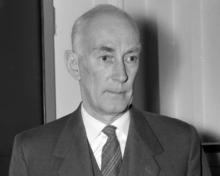Jan Oort | |
|---|---|
 Jan Oort in May 1961 | |
| Born | 28 April 1900 |
| Died | 5 November 1992 (aged 92) |
| Nationality | Dutch |
| Known for | |
| Awards | Vetlesen Prize (1966) Kyoto Prize (1987) |
| Scientific career | |
| Fields | Astronomy |
| Doctoral advisor | Jacobus Cornelius Kapteyn |



Jan Hendrik Oort ForMemRS[1] (/ˈɔːrt/ or /ˈʊərt/;[2] 28 April 1900 – 5 November 1992) was a Dutch astronomer who made significant contributions to the understanding of the Milky Way and who was a pioneer in the field of radio astronomy.[3] The New York Times called him "one of the century's foremost explorers of the universe";[4] the European Space Agency website describes him as "one of the greatest astronomers of the 20th century" and states that he "revolutionised astronomy through his ground-breaking discoveries."[5] In 1955, Oort's name appeared in Life magazine's list of the 100 most famous living people.[6] He has been described as "putting the Netherlands in the forefront of postwar astronomy".[4]
Oort determined that the Milky Way rotates and overturned the idea that the Sun was at its center. He also postulated the existence of the mysterious invisible dark matter in 1932, which is believed to make up roughly 84.5% of the total mass in the Universe and whose gravitational pull causes "the clustering of stars into galaxies and galaxies into connecting strings of galaxies".[4][7] He discovered the galactic halo, a group of stars orbiting the Milky Way but outside the main disk.[8] Additionally Oort is responsible for a number of important insights about comets, including the realization that their orbits "implied there was a lot more solar system than the region occupied by the planets."[4]
The Oort cloud, the Oort constants, Oort Limit, an impact crater on Pluto (Oort), and the asteroid 1691 Oort were all named after him.
- ^ Van De Hulst, H. C. (1994). "Jan Hendrik Oort. 28 April 1900 – 5 November 1992". Biographical Memoirs of Fellows of the Royal Society. 40: 320–26. doi:10.1098/rsbm.1994.0042.
- ^ "Oort". Oxford English Dictionary (Online ed.). Oxford University Press. (Subscription or participating institution membership required.)
- ^ Woltjer, Lodewijk (November 1993). "Obituary: Jan H. Oort". Physics Today. 46 (11): 104–05. Bibcode:1993PhT....46k.104W. doi:10.1063/1.2809110.
- ^ a b c d Wilford, John (12 November 1992). "Jan H. Oort, Dutch Astronomer In Forefront of Field, Dies at 92". New York Times. Retrieved 30 May 2014.
- ^ "Jan Hendrik Oort: Comet Pioneer". European Space Agency. Retrieved 30 May 2014.
- ^ Katgert-Merkelijn, J. (2000). "Jan Oort, astronomer : Catalogue of an exhibition in Leiden University library, April 20 - May 27, 2000". Jan Oort. Universiteitsbibliotheek Leiden. hdl:1887/77628.
- ^ Bertschinger, Edmund. "Dark Matter Cosmological". Retrieved 30 May 2014.
- ^ J. H. Oort; Arias, B; Rojo, M; Massa, M (June 1924), "On a Possible Relation between Globular Clusters and Stars of High Velocity", Proc Natl Acad Sci U S A, 10 (6): 256–60, Bibcode:1924PNAS...10..256O, doi:10.1073/pnas.10.6.256, PMC 1085635, PMID 16586938.